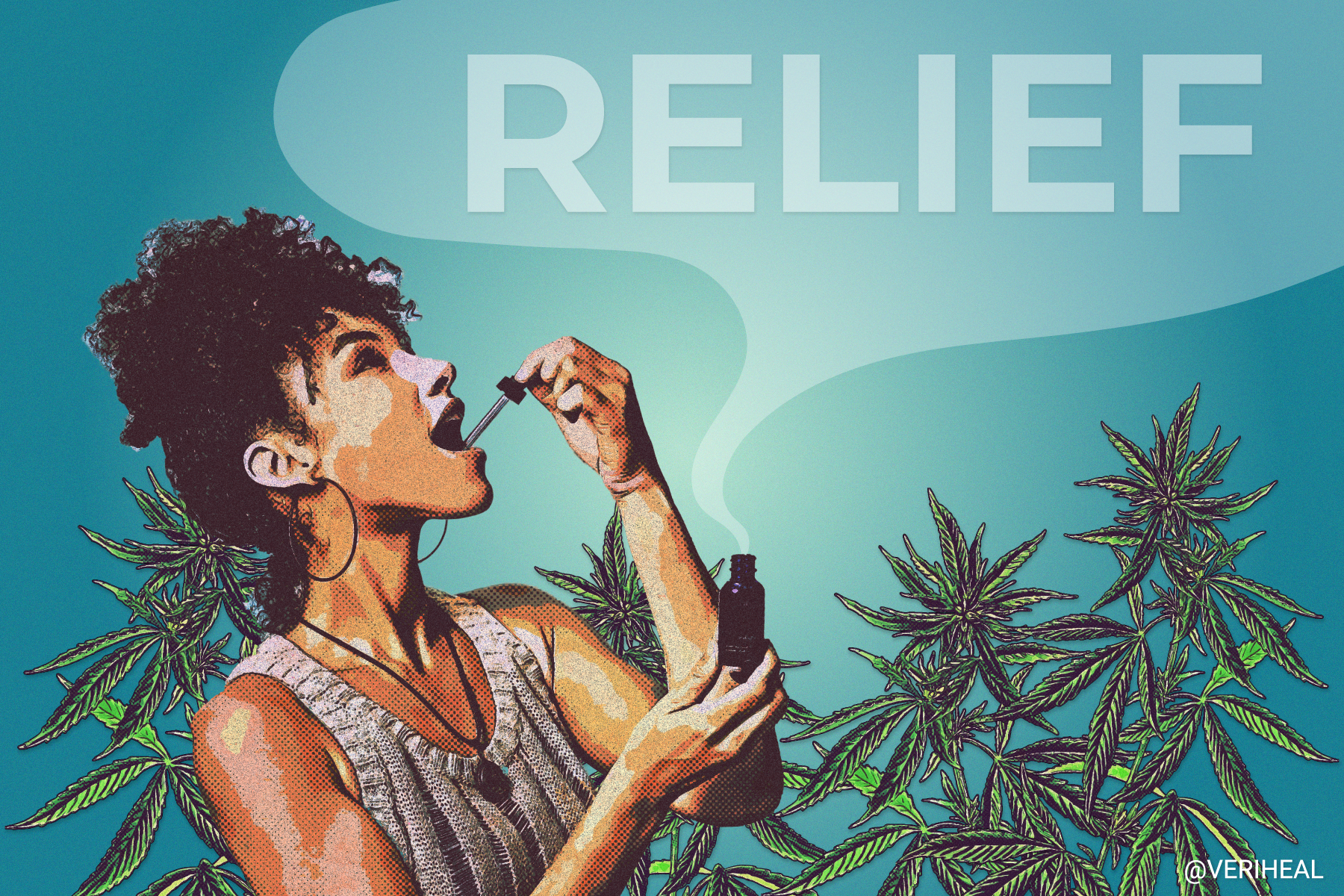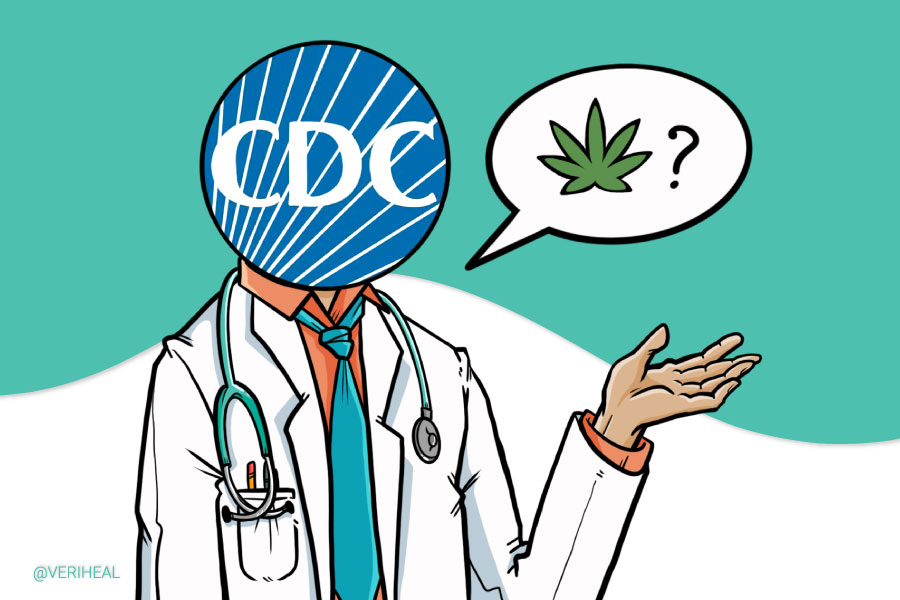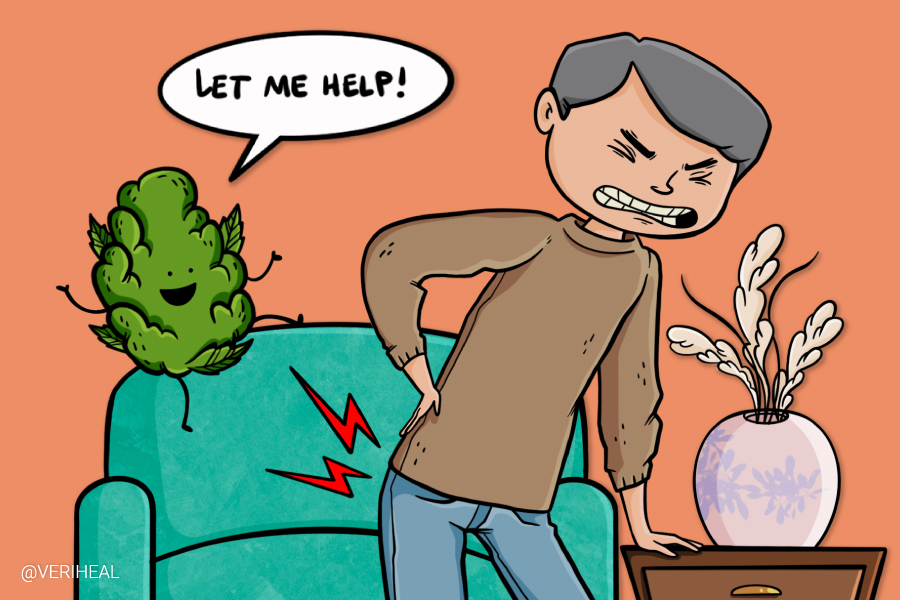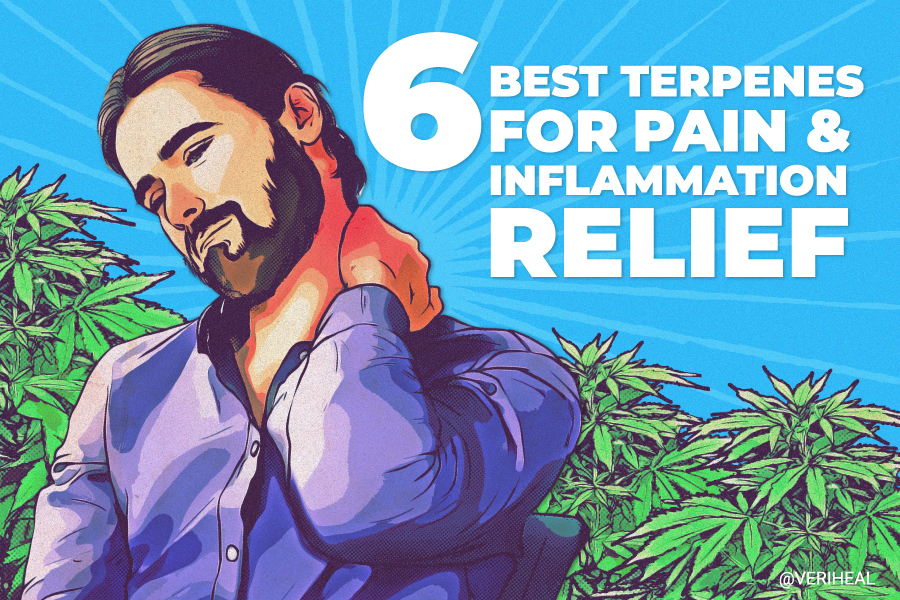Scoliosis and Medical Marijuana: How Can Medical Cannabis Helps To Treat Scoliosis?
- Scoliosis Signs, Symptoms and Types
- The Role of the Endocannabinoid System in Treating Scoliosis
- Scoliosis Treatment: Can Medical Cannabis Provide Relief?
- What Preparations of Cannabis are Best for Scoliosis
- Talk to Your Doctor about these Scoliosis Treatments
Three million children in the United States are faced with the reality of a new scoliosis diagnosis every single year (13). Instead of a worry-free childhood, 442,900 children with scoliosis will attend a doctor’s office to discuss their spinal curvature (1).
It’s not just children who can develop scoliosis, however. In fact, scoliosis affects some 6-9 million people across the U.S. (2). While it can develop in early childhood or infancy, this sideways curvature of the spine usually arises in adolescence, with the primary age of onset being 10-15 years of age. There are many subtypes of scoliosis that can be diagnosed based on age and cause.
Due to the aging demographic profile of the U.S., adolescent scoliosis is creating a huge dent on the U.S. economy, as well as the nation’s overall health. The good news is that cannabis-based medicines have natural anti-inflammatory and anxiolytic properties, thus enabling those who use them to feel more emotionally and physically stable (3).
Although there is a lack of direct studies, RCTs, and long-term, follow-up studies into the use of medicinal cannabis for scoliosis, more patients are asking their doctors about recommending cannabis for back pain. While cannabis cannot yet be considered an FDA-approved treatment as such, it is rapidly gaining attention as a potential aid for relieving the often debilitating symptoms associated with scoliosis.
So much so that the medical cannabis-friendly states of Florida and New York are respectively certifying patients who struggle with spinal disorders, such as scoliosis and spinal cord injury with spasticity. Certain states also allow medical professionals to recommend cannabis if a condition is considered to be “debilitating” which may apply.
Scoliosis Signs, Symptoms and Types
According to the Scoliosis Research Society (SRS), the radiological definition of scoliosis is any lateral spinal curvature with a Cobb angle that exceeds 10 degrees (7). In 80% of cases the cause of scoliosis is unknown. This type of scoliosis is referred to as idiopathic scoliosis.
In some situations, the cause of scoliosis is spinal disc degeneration, much like in cases of arthritis or osteoporosis. The condition has been known to arise in families, suggesting that it might be a hereditary condition. Biological girls are also eight times more likely to develop scoliosis that requires treatment.
There is also an association between scoliosis and conditions like cerebral palsy, myopathies (muscular dystrophy, polymyositis), connective tissue disorders (Marfan’s, Ehlers-Danlos syndrome), and other genetic conditions.
Some of the physical signs that may appear in scoliosis screening and prompt diagnostic x-rays include:
- Uneven shoulders, one or both shoulder blades may stick out
- Head is not centered directly above the pelvis
- Raised or unusually high hips
- Rib cages at different heights
- Uneven waist
- Skin abnormalities overlying the spine (like dimples, hairy patches, color abnormalities)
- The entire body leans to one side (2)
Diagnosed children will usually have their case monitored with the use of x-rays so as to observe if the curve intensifies, indicating the need for treatment. So long as the case is not considered severe, a patient may have the opportunity to use a brace to help straighten the curve without the need of surgical treatment.
There are six types of scoliosis diagnoses in children, based on age and cause:
- Infantile idiopathic scoliosis: 0-3 years, unknown cause
- Juvenile idiopathic scoliosis: 4-10 years, unknown cause
- Adolescent idiopathic scoliosis: ages 11 to 18, the most common type of scoliosis, unknown cause
- Congenital scoliosis: when the spine does not develop properly in the womb
- Neuromuscular scoliosis: caused by brain, spinal cord, and muscular system disorders
- Syndromic scoliosis: develops as part of an underlying syndrome or disorder (eg, Marfan syndrome, muscular dystrophy, etc) (13)
Adults generally fall into three categories of scoliosis:
- Adult scoliosis patients who were surgically treated as adolescents
- Adults who did not receive treatment when they were younger
- Adults with a type of scoliosis called degenerative scoliosis (2)
On the other end of the spectrum, when a spinal curvature is prominent, more in-depth imaging may be necessary, e.g. MRI scanning. Scoliosis patients with severe spinal curvatures will almost always end up undergoing surgery, with approximately 29,000 adolescent scoliosis surgeries being performed every year in the United States. That’s almost 80 surgeries per day, or three every hour (10).
Scoliosis Causes and Complications
Unfortunately for some people with scoliosis, the intensity of their curve can result in the hips and shoulders becoming uneven. It is also common for the waist and trunk to shift to the side. Consequently, the patient may become self-conscious of his or her appearance and struggle with maintaining a comfortable posture.
While one person may be able to lead a normal life without experiencing scoliosis-related pain (which can manifest in various parts of the body) for others it can be debilitating. Scoliosis is a lateral (sideways) curvature of the spine, which is normally fixed in a straight vertical line.
Left untreated, some cases of scoliosis can trigger the following side effects:
- Back pain
- Balance and equilibrium issues
- Digestive issues
- Headaches/migraines
- Hip pain
- Knee pain
- Leg pain
- Low bone density
- Neck pain
- Organ function problems
- Poor posture
- Poor oxygen intake
- Radicular (nerve) pain
About 10% of scoliosis patients may also suffer from an underlying associated condition that can complicate their scoliosis such as:
- Spondylolisthesis (vertebral slippage)
- Syringomyelia (fluid-filled cyst in the spinal cord)
- Tethered cord (abnormal tissue limitations of the spine)
- Herniated disc (sometimes called a “bulging” disc)
- Spinal tumor
Let’s not forget about the psychological side effects, too. Scoliosis places a heavy burden on a person’s emotional state, which may contribute to energy depletion, poor work/school performance, irritability, depressed mood, and sleep disturbances (8).
The Role of the Endocannabinoid System in Treating Scoliosis
The endocannabinoid system (ECS) regulates and controls many of our most critical bodily functions such as learning and memory, emotional processing, sleep, temperature control, pain control, inflammatory and immune responses, and eating. Since scoliosis can have a negative impact on many of these bodily functions, introducing cannabis into your daily health and wellness routine could prove to be very worthwhile.
A growing body of preliminary and survey research also suggests that the non-addictive and non-psychotropic component of the cannabis plant, CBD, may improve sleep quality, reduce pain, treat inflammation, and exert anxiolytic effects. CBD works by indirectly boosting the body’s endocannabinoid system.
The therapeutic properties of cannabis extend far beyond CBD, however. CBD’s psychoactive cousin THC (tetrahydrocannabinol) binds with CB1 and CB2 receptors in the ECS to alleviate pain, inflammation, relieve muscle spasms, and improve sleep.
Scoliosis Treatment: Can Medical Cannabis Provide Relief?
When determining a suitable treatment option for scoliosis, the doctor must first understand if the curve progression can be decreased or if it needs to be maintained. A chiropractic-centered approach to scoliosis treatment could help to minimize curvatures without going under the knife.
A systematic review and meta-analysis of scoliosis patients found that Pilates exercise may also help with scoliosis by improving poor posture (5). This mind-body workout may help to maintain body balance and strengthen the muscles necessary for postural stability.
Many patients will also use over-the-counter pain relievers like NSAIDs or acetaminophen as first-line temporary treatments. In rare or most severe circumstances, opioid painkillers are sparingly used to relieve pain in scoliosis.
However, unlike with medical marijuana treatment, opioid use can frequently cause dependency and addiction. In cases of overusing pain medications, negative side effects on internal organs like the stomach, kidneys, and liver plus fatal overdoses are common. The same cannot be said for marijuana use, which has never caused a fatal overdose.
Investigative studies that were published in the New England Journal of Medicine indicate that bracing minimizes the risk of curve progression in adolescent scoliosis (16). The history of spinal brace treatment traces back to the 16th century, when French military surgeon Ambroise Paré advocated metal braces designed by an armorer for scoliosis.
A systematic review, titled, “The Efficacy of Cannabis in Reducing Back Pain,” confirmed that cannabis can effectively relieve back pain (both surgical and non-surgical) with a reasonable side effect profile (12). They noted, however, that long-term follow up is lacking. In a separate study, cannabinoids like delta-9 THC (tetrahydrocannabinol), cannabidiol (CBD), cannabinol (CBN), and others are shown to possess natural pain-relieving and anti-inflammatory qualities. These two therapeutic powers could provide scoliosis patients with symptomatic relief (9).
Another study published in the journal Pain assessed chronic pain patients’ experiences using medical marijuana. As per the results, two-thirds of the 984 chronic pain patients who participated in the study—including patients who suffer from arthritis, abdominal pain, back pain, headaches, neuropathic pain, and post-surgical pain—praised the plant’s pain-relieving qualities (11). Similar studies have been consistent with these results.
A 2016 study that looked at medical cannabis use and its potential to help chronic pain patients with symptom management found that, “using medical cannabis for chronic pain (CP) treatment may benefit some CP patients. The reported improvement in quality of life, better side effect profile, and decreased opioid use (4).”
Another study that sought to establish an understanding of socio-demographics and reasons of medical marijuana patients for using medical cannabis found that in the sample they surveyed, “69% of participants reported experiencing chronic pain and described feeling “much better” with the use of medicinal marijuana (85%) (17).”
A study published in 2005 surveyed 147 Australians using medical cannabis for a variety of reasons including chronic pain (57%) and depression (56%) among others. The survey found that, “cannabis was perceived to provide “great relief” overall (86%), and substantial relief of specific symptoms such as pain, nausea and insomnia. It was also typically perceived as superior to other medications in terms of undesirable effects, and the extent of relief provided (15).”
What Preparations of Cannabis are Best for Scoliosis?
Cannabis is an incredibly diverse plant. Not only are there many different strains or chemovars to choose from—each of which contains a unique cannabinoid ratio and terpenoid profile—but there are also plenty of product types and preparations to choose from. Examples include raw flower, extracts (e.g. wax, budder, shatter, and oil), tinctures (sublingual oil), and edibles.
If you’re hoping to use cannabis for scoliosis pain relief, why not apply topical gels and creams to the back for localized relief? Taking CBD orally in the form of a tincture is recommended for discrete dosing, no airway side effects, and fast, longer-lasting results.
Alternatively, opt for inhalable cannabis (e.g. joints and vapes) that release their effects within minutes. There’s also the option to ingest cannabis (e.g. oil-infused edibles, beverages, and tinctures) for longer-lasting effects. A Veriheal cannabis coach can help you choose the right cannabis product types and inform you about the vast dispensary lineup.
Talk to Your Doctor About These Scoliosis Treatments
Once a patient has been diagnosed with scoliosis, he or she will be referred to an orthopedic doctor who will specialize in providing the right type of treatment. The way in which your condition is dealt with depends on the type of scoliosis you are diagnosed with, your age, and the measurement of your curvature.
On average, a three-day hospital stay for adults costs $30,000 without insurance, according to healthcare.gov. These costs may vary based on surgical need, insurance, and location (6). Still, scoliosis accounts for 1.2% of all hospital charges, thus proving just how much of a burden scoliosis places on the U.S. economy.
Insurance coverage does not cover medical marijuana, but this doesn’t mean that you cannot find affordable cannabis medicines. Obtaining a written recommendation starts with a doctor consultation.
Complementary Treatments Worth Discussing with Your Doctor
The more active your lifestyle, the stronger your back muscles will be. Swimming, pilates, physical therapy, and yoga are recommended for pre-operative and post-operative scoliosis patients.
Many different types of massage can also help, including deep tissue scoliosis massage, Swedish massage, sports massage, and Shiatsu, which is a type of Japanese bodywork.
Your doctor might also advise you to try cranial-sacral therapy, since this type of massage works by stimulating the restricted tissues surrounding the spine.
There are several options available to scoliosis patients to manage the symptoms of scoliosis. Whether you’re dealing with congenital, idiopathic, neuromuscular, or degenerative scoliosis, it’s advisable to consult with one of Veriheal’s cannabis coaches to discuss your options.
Veriheal’s knowledgeable team of consultants will do the hard work on your behalf, so you can sit back and relax while we connect you with a licensed doctor. You can also put your trust in Veriheal to set you up with a personalized cannabis coach for more information, and to recommend the best dispensaries.
Speak with a member of our team today to find out if you qualify for a medical marijuana card.
Note: The content on this page is for informational purposes only and is not intended to be professional medical advice. Do not attempt to self-diagnose or prescribe treatment based on the information provided. Always consult a physician before making any decision on the treatment of a medical condition.
1. HCUP Databases. Healthcare Cost and Utilization Project (HCUP). September 2021. Agency for Healthcare Research and Quality, Rockville, MD. www.hcup-us.ahrq.gov/nisoverview.jsp
2. American Association of Neurological Surgeons. (n.d.). Scoliosis. AANS. Retrieved August 10, 2022, from https://www.aans.org/Patients/Neurosurgical-Conditions-and-Treatments/Scoliosis#:~:text=Scoliosis%20affects%202%2D3%20percent,occurring%20equally%20among%20both%20genders
3. Atalay, S., Jarocka-Karpowicz, I., & Skrzydlewska, E. (2019). Antioxidative and anti-inflammatory properties of Cannabidiol. Antioxidants, 9(1), 21. https://www.ncbi.nlm.nih.gov/pmc/articles/PMC7023045/
4. Boehnke, K. F., Litinas, E., & Clauw, D. J. (2016). Medical cannabis use is associated with decreased opiate medication use in a retrospective cross-sectional survey of patients with chronic pain. The Journal of Pain, 17(6), 739–744. https://pubmed.ncbi.nlm.nih.gov/27001005/
5. Gou, Y., Lei, H., Zeng, Y., Tao, J., Kong, W., & Wu, J. (2021). The effect of pilates exercise training for scoliosis on improving spinal deformity and quality of life. Medicine, 100(39). https://www.ncbi.nlm.nih.gov/pmc/articles/PMC8483862/
6. Health coverage protects you from high medical costs. HealthCare.gov. (n.d.). Retrieved August 10, 2022, from https://www.healthcare.gov/why-coverage-is-important/protection-from-high-medical-costs/
7. Knipe, H. (2022, January 19). Scoliosis: Radiology reference article. Radiopaedia Blog RSS. Retrieved August 10, 2022, from https://radiopaedia.org/articles/scoliosis?lang=us
8. Mayo Foundation for Medical Education and Research. (2022, May 4). Scoliosis. Mayo Clinic. Retrieved August 10, 2022, from https://www.mayoclinic.org/diseases-conditions/scoliosis/symptoms-causes/syc-20350716
9. Nagarkatti, P., Pandey, R., Rieder, S. A., Hegde, V. L., & Nagarkatti, M. (2009). Cannabinoids as novel anti-inflammatory drugs. Future Medicinal Chemistry, 1(7), 1333–1349. https://www.ncbi.nlm.nih.gov/pmc/articles/PMC2828614/
10. Nalda, T. (2021, February 25). 9 surprising scoliosis statistics. Scoliosis Reduction Center. Retrieved August 10, 2022, from https://www.scoliosisreductioncenter.com/blog/9-surprising-scoliosis-statistics#:~:text=Every%20year%20in%20the%20United,day%20%E2%80%94%20and%20three%20every%20hour!
11. Piper, B. J., Beals, M. L., Abess, A. T., Nichols, S. D., Martin, M. W., Cobb, C. M., & DeKeuster, R. M. (2017). Chronic pain patients’ perspectives of Medical Cannabis. Pain, 158(7), 1373–1379. https://www.ncbi.nlm.nih.gov/pmc/articles/PMC5845915/
12. Price, R. L., Charlot, K. V., Frieler, S., Dettori, J. R., Oskouian, R., & Chapman, J. R. (2022). The efficacy of cannabis in reducing back pain: A systematic review. Global Spine Journal, 12(2), 343–352. https://pubmed.ncbi.nlm.nih.gov/35128969/
13. Schaffrey, C. (2016, November 8). Scoliosis in children. Spine Universe. Retrieved August 10, 2022, from https://www.spineuniverse.com/conditions/scoliosis/scoliosis-children
14. Scoliosis Research Society. SRS. (n.d.). Retrieved August 10, 2022, from https://www.srs.org/patients-and-families/conditions-and-treatments/adolescents/diagnosing-scoliosis
15. Swift, W., Gates, P., & Dillon, P. (2005). Survey of Australians using cannabis for medical purposes. Harm Reduction Journal, 2(1). https://pubmed.ncbi.nlm.nih.gov/16202145/
16. Weinstein, S. L., Dolan, L. A., Wright, J. G., & Dobbs, M. B. (2013). Effects of bracing in adolescents with idiopathic scoliosis. New England Journal of Medicine, 369(16), 1512–1521. https://www.nejm.org/doi/full/10.1056/nejmoa1307337
17. Zaller, N., Topletz, A., Frater, S., Yates, G., & Lally, M. (2015). Profiles of medicinal cannabis patients attending Compassion Centers in Rhode Island. Journal of Psychoactive Drugs, 47(1), 18–23. https://pubmed.ncbi.nlm.nih.gov/25715068/









